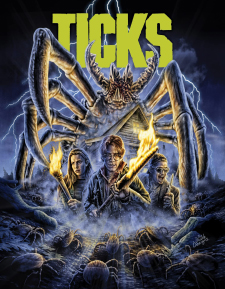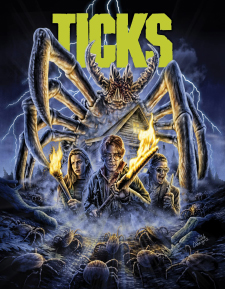Ticks (4K UHD Review)

Director
Tony RandelRelease Date(s)
1993 (October 26, 2021)Studio(s)
First Look Pictures/Republic Pictures (Vinegar Syndrome)- Film/Program Grade: B-
- Video Grade: A-
- Audio Grade: B-
- Extras Grade: B+
Review
Despite the fact that it consists of just a single word, Ticks is a wonderfully evocative title for a horror film. It practically sells itself. Just that word, plus a simple poster, and there’s no need for anything else. You’ll either watch the film based on the title alone, or you won’t, and nothing else is going to change your mind. But anyone who lives in an area where ticks are prevalent will intuitively grasp the potential contained within that title, and the film delivers appropriate levels of grue to match.
Ticks was the brainchild of makeup artist Doug Beswick, though the final shooting script was by Brent V. Friedman, with everyone else contributing ideas along the way. The basic narrative has Holly (Rosalind Allen) and Charles (the late great Peter Scolari) taking a group of troubled teens on a therapeutic trip to the wilderness, where they encounter, well, mutant ticks. The story could charitably be described as a bit muddled, with the explanation for the cause of the mutations providing an unnecessary source of conflict in addition to the obvious one—when you have giant, bloodsucking mutant ticks, you really don’t need anything else. But the leads make likable protagonists, and the group of teens is filled out with memorable young actors like Seth Green, Ami Dolenz, and Alfonso Ribeiro. All that, plus Clint Howard in maximum Clint Howard Mode (and even a cameo appearance by his father Rance).
Of course, it’s the ticks that are the selling point here, and the effects work by Beswick (with additions by KNB) are an enjoyable throwback to the era when makeup artists were still the rock stars of the effects world. There’s a lot of particularly clever work to create large groups of ticks scampering though the woods, and while they would have been easier to create with CGI, they wouldn’t have looked any better than they do here. The stop-motion animation work actually integrates quite well with the puppet and animatronic effects—it isn’t seamless, but the match between the techniques is smoother than most other films of the era. There’s even an appropriately disgusting payoff for anyone who knows the first rule about removing ticks—you’ll see what’s coming long before the character does.
Ticks was directed by Tony Randel, who had already proved his ability to handle effects-driven films with Hellbound: Hellraiser II. He keeps things moving quickly from one set piece to the next—whatever else can be said about Ticks, it’s never dull. As rickety as the narrative framework may be, it’s really just there to hold those set pieces together, and it’s clear that Randel understood that fact. Ticks has no ambitions beyond being a fun monster film, but that’s more than enough.
Cinematographer Steve Grass shot Ticks on 35 mm photochemical film using spherical lenses, framed at the 1.85:1 aspect ratio for its theatrical release. For this Ultra HD version, the interpositive was scanned at 4K resolution and graded for HDR (only HDR10 is included on the disc). There’s no indication about whether or not the original negative was even available, but Vinegar Syndrome describes this as a “never-before-seen extended version,” so it may have only existed on the IP. This cut runs 88 minutes, which is three minutes longer than the original theatrical and home video releases. Despite the secondary source, the image carries a surprising amount of fine detail, and everything appears to have been cleaned up meticulously. The grain is slightly more pronounced than it would have been from a scan of the negative, but it’s even throughout the entire film, and the encoding manages it perfectly (aside from the commentaries, there are no extras on the UHD in order to maximize the bit rate). The HDR grade provides strong contrast, with really deep blacks. The brightest highlights occasionally push the edge of appearing blown out, but they never go too far. (For those who may have issues with flashing light patterns, please note that the HDR does accentuate some of the stroboscopic lighting effects in the film.) The colors are richly saturated in this version, with lush greens for the foliage, plus brilliant blues and reds in the costuming. The included Blu-ray looks fine on its own terms, but it’s much paler in comparison to the UHD. This is a major upgrade for a film that only received a limited theatrical release—those who first experienced it on VHS will be shocked at how good that it looks.
Audio is offered in English 2.0 DTS-HD Master Audio, with optional English subtitles. The theatrical release of Ticks was encoded in Surround Trax Surround Stereo, which was a matrixed surround format similar to Dolby Stereo or Ultra Stereo. Properly decoded, it’s a four-channel mix. That’s immediately obvious in the opening scenes, where the sound of thunder is steered to the surrounds, and there are similar surround effects throughout. It’s a generally fine mix, but there are issues with distortion in the dialogue, with some unusually excessive sibilance. For example, in the conversation between Rosalind Allen and Peter Scolari that begins at 21:45, the “S” sounds in Allen’s lines are particularly harsh and unpleasant. It may be digital distortion caused by clipping, rather than anything inherent in the original recordings. Fortunately, it doesn’t occur too often, but it’s distracting when it appears. And it’s the only major issue in an otherwise solid track.
Vinegar Syndrome’s Ultra HD release of Ticks is a 2-disc set which includes a Blu-ray copy of the film, as well as a limited edition slipcover and a reversible sleeve—once side with newly commissioned artwork by Tom Hodge and Earl Kess, and the other with the original art. The following extras are included, all of them in HD:
DISC ONE (UHD)
- Archival Audio Commentary with Tony Randel, Clint Howard, and Nathaniel Thompson
- New Audio Commentary with Doug Beswick, Yancy Calzada, and Joe Begos
DISC TWO (BD)
- Archival Audio Commentary with Tony Randel, Clint Howard, and Nathaniel Thompson
- New Audio Commentary with Doug Beswick, Yancy Calzada, and Joe Begos
- Under the Skin: The Making of Ticks Part 1: Origins (10:12)
- Under the Skin: The Making of Ticks Part 2: Metamorphosis (14:08)
- Under the Skin: The Making of Ticks Part 3: New Blood (14:47)
The first commentary with Tony Randel and Clint Howard was originally recorded for the 2013 Olive Films Blu-ray release. It offers some interesting anecdotes about the production, but even with Thompson’s gentle prodding, there are still many gaps throughout. Given the fact that Howard’s role wasn’t originally part of the film, but was instead added during reshoots, they understandably spend some time talking about that process. They also briefly cover the place that Ticks had in the era when independent genre filmmaking transitioned from theatrical releases to going direct-to-video instead. They spend some time reacting to what’s happening on screen rather than commenting about it, but there’s still enough information here to make the track worth a listen.
The second commentary with Doug Bewick and Yancy Calzada is understandably a bit more technically focused. They discuss the development of the story and provide explanations of how the effects were filmed, giving due credit to the other artists who were involved. They also discuss the reshoots, including KNB’s involvement. One nice aspect of this track is that they did their homework by listening to the Tony Randel and Clint Howard commentary first, so they end up complementing it rather than merely duplicating what the other two had to say. They’re also more than willing to acknowledge what doesn’t work in the film. Once again, there are a few lengthy gaps here and there, but it’s still a good track to learn more about the film.
Under the Skin features interviews with Doug Beswick, Brent Friedman, Bryan Yuzna, Tony Randel, Ami Dolenz, Rosalind Allen, Leslie Rosenthal, and Christopher Stone. Origins covers the background of the project, with some biographical details. Beswick explains how he spent decades trying to get it off the ground, and there’s some discussion about how the film developed. The wildest ideas naturally came from Yuzna, while Randel pushed to try to keep things more grounded. Metamorphosis looks at the actual production, including the locations, the original effects work, and casting. Randel points out how one of the casting directors, Robin Monroe, left the business to found the Color Me Mine pottery franchise, and how he wishes that he had invested in it. New Blood explores the four days of reshoots, where KNB joined to create the birth of the giant tick, and all of Clint Howard’s scenes were added. It also looks at the rest of post-production, including the scoring. Interestingly, Christopher Stone misidentifies the closing credit music for Alien as having been written by Jerry Goldsmith, despite the fact that he had interned with the legendary composer. There’s also a brief look at the aborted ad campaign under the title Infested.
It goes without saying that Ticks isn’t for everyone, but once again, the title made that point perfectly clear. But for fans of the genre and special makeup effects, there’s plenty here to enjoy, and it looks fantastic in 4K, regardless of the source.
- Stephen Bjork
(You can follow Stephen on Facebook at this link)

